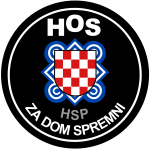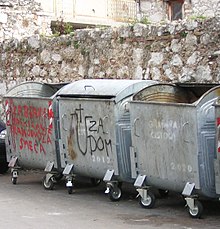Za dom spremni

Za Dom! (For the homeland!) Is a Croatian battle cry that was first used in the 16th century during the Turkish Wars. It can be found as a military salute as well as in speech , literature , poetry , music and sport .
The best known variant is Za Dom - Spremni! (For home - ready!). Since the 1930s this has been the motto and greeting of the fascist Ustasha , who also used the modified long form Za Poglavnika i Dom - Spremni! (For the Führer and the home - ready!) Used. With "Poglavnik" is meant Ante Pavelić , who was the leader of the Ustaše and dictator of the Independent State of Croatia (NDH).
Since the Croatian War (1991 to 1995) Za Dom - Spremni! again use, but is extremely controversial as the equivalent of the fascist salute. The use of the greeting in Croatia may violate the Law on Public Order, the Right of Assembly and the Law on the Prevention of Unrest in Sports Competitions and lead to criminal prosecution.
Origins
The Croatian greeting or appeal Za dom (For the homeland) without the reply Spremni! (Ready!) Can be found several times in Croatian history without a fascist or nationalist background.
The Za dom call can be found several times in Paul Ritter Vitezović's work Odiljenje sigetsko from 1684, which deals with the siege of Szigetvár and the fallen Croatian general Nikola Šubić Zrinski .
Independent state of Croatia
First only greetings from the Ustasha, should Za Dom - Spremni! after the takeover of power and the establishment of a totalitarian dictatorship in the form of the Independent State of Croatia as a binding greeting from all. This Ustaše state, which existed from 1941 to 1945, was responsible for racial laws and genocide against various ethnic groups, mainly Serbs , Jews and Roma , and the murder of numerous political opponents. Analogous to the Hitler salute ("German greeting") it was also referred to as "Croatian greeting" in Ustascha parlance and, for example, official letters to German authorities ended with the greeting formula "With Croatian greeting, Za dom spremni!". In rapprochement with the fascist Kingdom of Italy and National Socialist Germany , it was connected as a spoken greeting with the gesture of the raised right arm (" Roman greeting "). It was used on internal party and state badges , medals and decorations as well as on documents as a final greeting (for example, when awards were given). The state propaganda stated, among other things:
"U Poglavnikovoj Hrvatskoj pozdravlja se jedino ustaškim pozdravom: Za dom - spremni!"
"In the Croatia of Poglavnik you only greet each other with the Ustasha greeting: For home - ready!"
and also
"Naš pozdrav je: Za dom - spremni !, Za poglavnika i za dom - spremni!"
"Our greeting is: For home - ready! For leader and home - ready!"
A German Wehrmacht officer of the " Croatian Legion " was told about the greeting:
“Za dom! That means: for the homeland! - That is the Croatian greeting in this war, the movement's greeting, so to speak, corresponding to our Heil Hitler. ”[…]“ The answer, ”continued the lieutenant,“ is: Spremni! We are ready! - You can tell from the way it comes out what kind of brainchild people are. "
Croatian and Bosnian wars

During the Croatian and Bosnian wars , some Croatian military units used the motto “Za Dom!” Or “Za Dom - Spremni!” On their badges, for example . The right-wing Croatian HOS militia also used it as a binding spoken greeting together with the gesture of the raised right arm.
present

The Ustasha greeting has been celebrated regularly in Croatia's stadiums since the 1990s.
After successfully qualifying for the 2014 World Cup on November 19, 2013, the Croatian international Josip Šimunić caused a scandal . After the 2-0 win in the second leg against Iceland in Zagreb, the defender took the stadium microphone and shouted “Za Dom” five times to the fans, whereupon the audience answered him with “Spremni!”. On the following weekend several thousand supporters of Hajduk Split , Torcida Split , the Ustascha salute at the home game against NK Osijek in the Poljud Stadium and "Let's go, Ustaschas!" The singing greeting was dedicated to Šimunić. In December 2013, Šimunić was banned from public use of the greeting during a stadium announcement by FIFA for the 2014 World Cup, was banned from the stadium and fined 30,000 Swiss francs. In its judgment, the FIFA Disciplinary Commission came to the conclusion "that this greeting is discriminatory and offends the dignity of a group of people, among other things with regard to race, religion or origin". The Croatian judiciary had already sentenced Šimunić to a fine of 3,200 euros in November 2013.
At concerts of the controversial Croatian rock band Thompson , fans of the band sometimes appear in black clothing and other symbols of the Ustasha “ Black Legion ”. The greeting is often chanted.
literature
- Marko Samardžija: Hrvatski jezik u Nezavisnoj Državi Hrvatskoj [The Croatian language in the Independent State of Croatia] . Hrvatska Sveučilišna Naklada, 1993, ISBN 978-953-169-003-4 .
- General Drinjanin (di Vjekoslav Luburić ): Naš vojnički pozdrav [Our soldier's greeting] . In: Drina . No. 1 . Spain 1963.
Individual evidence
- ↑ Marko Samardžija: Jezični purizam u NDH: Savjeti Hrvatskoga državnog ureda za jezik [Language purism in the NDH: Guidelines of the Croatian State Office for Language] (= Biblioteka Jezikoslovlje, Nakladnički projekt Verbum Croaticum ). Hrvatska Sveučilišna Naklada, 1993, ISBN 978-953-169-005-8 , p. 23 .
- ^ Spiegel online: Simunic cheers with a fascist Ustaša slogan. Retrieved November 20, 2013 .
- ↑ derstandard.at: Josip Šimunić causes outrage. Retrieved November 20, 2013 .
- ↑ Norbert Mappes-Niediek: The greeting from Simunic violates three laws. In: Die Welt, December 17, 2013. Retrieved March 15, 2014 .
- ↑ Ivanka Toma: Zbog 'Za dom spremni' dosad podignuto 13 prekršajnih prijava. In: Večernji list, November 22, 2013. Retrieved March 15, 2014 .
- ↑ Paul Knight Vitezović : Oddiljenja Sigetskoga čentiri dela: S uvodom životu Nikole kneza Zrinjskoga . Zagreb 1836, p. 44, 50 ( google.hr ).
- ↑ Hans-Christoph Seidel: Forced Labor in the Mine: Documents . Ed .: Klaus Tenfelde, Hans-Christoph Seidel, Jens Adamski (= Volume 2 of Forced Labor in the Mine: The Labor Use in Coal Mining of the German Reich and the Occupied Territories in the First and Second World War, publications of the Institute for Social Movements: Labor Use and Forced Labor in Mining ). Klartext, 2005, ISBN 978-3-89861-390-3 , p. 657 .
- ^ Marko Samardžija: Hrvatski jezik u Nezavisnoj Državi Hrvatskoj [The Croatian language in the Independent State of Croatia] . Hrvatska Sveučilišna Naklada, 1993, ISBN 978-953-169-003-4 , p. 57 .
- ↑ Adolf von Ernsthausen: The Wolves of the Lika: With legionaries, Ustaschi, Domobranen and Tschetniks against Tito's partisans: Experiences in Croatia 1944 . Kurt Vowinckel Verlag, Neckargemünd 1959, p. 24 .
- ^ Wiener Zeitung : The past plays a role
- ↑ Neue Osnabrücker Zeitung: Cheers from soccer player Simunic stirs up Croatia. Retrieved November 29, 2013 .
- ↑ Šimunić is refused after the "Croatian greeting" World Cup , Süddeutsche Zeitung of December 16, 2013
- ↑ Die Welt: On a long journey with the Ustaša greeting